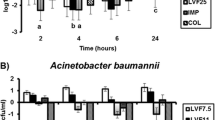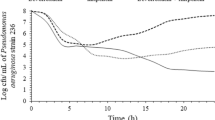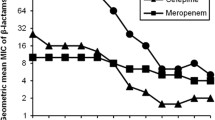Summary
The effect of decreasing concentrations of azlocillin and sisomicin onPseudomonas aeruginosa was examined. Logarithmically growing bacterial cultures were incubated in an ultrafiltration cell, and after adding the antibiotics, the culture medium was diluted every 20 min without any decrease in cell density. The turn-over of medium resulted in the elimination of azlocillin with a half-life of 75 min. This simulated serum kineticsin vivo. When testing sisomicin, small amounts of this agent were added during every dilution step to achieve a half-life of 120 min. Growth conditions were comparable in all experiments. The simultaneous combination of azlocillin and sisomicin resulted in strong synergism as assessed by higher killing rates and more prolonged growth inhibition of surviving bacteria. Comparable results were observed when both drugs were added at intervals of 40 min. When applied at intervals of 120 min, the combined effect of azlocillin and sisomicin was reduced, but still superior to the effect of double the concentration of each compound alone. Thus, neither pre-treatment with azlocillin nor with sisomicin impaired the antibacterial activity of the combination partner. This seems to be of clinical importance since the agents may be administered at different times during combined therapy.
Zusammenfassung
Untersucht wurde die Wirkung abnehmender Konzentrationen von Azlocillin und Sisomicin aufPseudomonas aeruginosa. Nach Zugabe der Wirkstoffe zu einer logarithmisch wachsenden Bakterienkultur in einer Ultrafiltrationszelle wurde das Kulturmedium alle 20 min ohne Ausschwemmung von Keimen verdünnt. Durch den Austausch des Mediums wurde Azlocillin entsprechend derin vivo beobachteten Serumkinetik mit einer Halbwertszeit von 75 min eliminiert. Bei Prüfung von Sisomicin wurden geringe Mengen dieses Wirkstoffes bei jedem Verdünnungsschritt ergänzt, um eine Halbwertszeit von 120 min zu erzielen. In allen Versuchsansätzen herrschten vergleichbare Wachstumsbedingungen. Gleichzeitige Kombination von Azlocillin und Sisomicin führte zu einem starken Synergismus, der sich in höheren Abtötungsraten und länger anhaltender Wachstumshemmung der überlebenden Keime äußerte. Vergleichbare Ergebnisse wurden beobachtet, wenn beide Wirkstoffe im Abstand von 40 min zugesetzt wurden. Ein zeitlicher Abstand von 120 min führte zu einer Abschwächung des synergistischen Effektes, doch übertraf die Kombination in ihrer Wirkung noch immer die jeweils doppelten Konzentrationen der Einzelsubstanzen. Somit führte weder eine Vorbehandlung mit Azlocillin noch mit Sisomicin zu einer Beeinträchtigung der antibakteriellen Wirksamkeit des Kombinationspartners. Dies scheint von klinischer Bedeutung, da die Wirkstoffe bei kombinierter Therapie zu verschiedenen Zeitpunkten verabreicht werden können.
Similar content being viewed by others
Literature
Parker, R. F., Marsh, H. C. The action of penicillin on staphylococcus. J. Bacteriol. 51 (1946) 181–186.
Parker, R. F., Luse, S. The action of penicillin on staphylococcus: Further observations on the effect of a short exposure. J. Bacteriol. 56 (1948) 75–81.
Eagle, H., Musselman, A. D. The slow recovery of bacteria from the toxic effects of penicillin. J. Bacteriol. 58 (1949) 475–490.
Rolinson, G. N. Plasma concentrations of penicillin in relation to the antibacterial effect. In:Davies, D. S., Prichard, D. N. C. (eds.): Biological effects in relation to their plasma concentration. Macmillan, London 1973, pp. 183–189.
Shah, P. M., Hübner, K.-G., Stille, W. In-vitro-Untersuchungen zur intermittierenden Therapie mit Penicillin G und Ampicillin. Med. Welt 29 (1978) 888–892.
Wilson, D. A., Rolinson, G. N. The recovery period following exposure of bacteria to penicillins. Chemotherapy 25 (1979) 14–22.
Sanfilippo, A., Morvillo, E. An experimental model for the study of the antibacterial activity of the sulfonamides. Chemotherapy 13 (1969) 54–60.
Grasso, S., Meinardi, G., De Carneri, I., Tamassia, V. Newin vitro model to study the effect of antibiotic concentrations and rate of elimination on antibacterial activity. Antimicrob. Agents Chemother. 13 (1978) 570–576.
Bergan, T., Carlsen, I. B., Fuglesang, J. E. Anin vitro model for monitoring bacterial responses to antibiotic agents under simulatedin vivo conditions. Infection 8 Suppl. 1 (1980) S 96-S 102.
Bergan, T., Carlsen, I. B. Bacterial kill rates of amoxicillin and ampicillin at exponentially diminishing concentrations simulatingin vivo conditions. Infection 8 Suppl. 1 (1980) S 103-S 108.
Wiedemann, B. Microbiologic basis of antibiotic therapy. Infection 8 Suppl. 1 (1980) S 6-S 13.
Murakawa, T., Sakamoto, H., Hirose, T., Nishida, M. Newin vitro kinetic model for evaluating bactericidal efficacy of antibiotics. Antimicrob. Agents Chemother. 18 (1980) 377–381.
Klaus, U., Henninger, W., Jacobi, P., Wiedemann, B. Bacterial elimination and therapeutic effectiveness under different schedules of amoxicillin administration. Chemotherapy (Basel) 27 (1981) 200–208.
Nishida, M., Murakawa, T., Kamimura, T., Okada, N., Sakamoto, H., Fukada, S., Nakamoto, S., Yokota, Y., Miki, K. Laboratory evaluation of FR 10612, a new oral cephalosporin derivative. J. Antibiot. 29 (1976) 444–459.
Nishida, M., Murakawa, T., Kamimura, T., Okada, N. Bactericidal activity of cephalosporins in anin vitro model simulating serum levels. Antimicrob. Agents Chemother. 14 (1978) 6–12.
Randolph, J. A., Buck, R. E., Price, K. E., Leitner, F. Comparative bactericidal effect of ceforanide (BL-S 786) and five other cephalosporins in anin vitro pharmacokinetic model. J. Antibiot. 32 (1979) 727–733.
O'Grady, F., Mackintosh, I. P., Greenwood, D., Watson, B. W. Treatment of “bacterial cystitis” in fully automatic mechanical models simulating conditions of bacterial growth in the urinary bladder. Br. J. Exp. Pathol. 54 (1973) 283–290.
Greenwood, D., O'Grady, F. Response of ampicillin resistantEscherichia coli to cephalosporins in anin vitro model simulating conditions of bacterial growth in the urinary bladder. Br. J. Exp. Pathol. 56 (1975) 167–171.
Shah, P. M., Peter, E., Stille, W. The bactericidal activity of decreasing concentrations of azlocillin and ticarcillin againstPseudomonas aeruginosa. In:Siegenthaler, W., Weuta, H. (eds.): International symposium acylureido-penicillins. Vienna 1979, Excerpta Medica, Amsterdam 1980, pp. 22–31.
Shah, P. M. An improved method to study antibacterial activity of antibiotics in anin vitro model simulating serum levels. Methods Findings Exp. Clin. Pharmacol. 2 (1980) 171–176.
Shah, P. M., Hessberger, U. Vergleichende Untersuchungen zur bakteriziden Aktivität von Ampicillin und Amoxycillin. Therapiewoche 31 (1981) 805–812.
Al-Asadi, M. J. S., Greenwood, D., O'Grady, F. In vitro model simulating the form of exposure of bacteria to antimicrobial drugs encountered in infection. Antimicrob. Agents Chemother. 16 (1979) 77–80.
Sakamoto, H., Hirose, T., Murakawa, T., Nishida, M. Bactericidal activity of antibiotics inin vitro model simulating antibiotic levels in body (3). Incorporation of cefazolin into the dialysis cell. Chemotherapy (Tokyo) 28 (1980) 842–827.
Daschner, F. In-vitro-Kombinationswirkung von Carbenicillin, Mezlocillin und Azlocillin mit Gentamicin und Sisomicin aufPseudomonas aeruginosa, Serratia marcescens, Klebsiella pneumoniae und indol-positiveProteus-Stämme. Infection 4 Suppl. 4 (1976) S 331-S 336.
Author information
Authors and Affiliations
Rights and permissions
About this article
Cite this article
Haller, I. Combined action of decreasing concentrations of azlocillin and sisomicin on pseudomonas aeruginosa as assessed in a dynamic in vitro model. Infection 10 (Suppl 3), S229–S233 (1982). https://doi.org/10.1007/BF01640679
Issue Date:
DOI: https://doi.org/10.1007/BF01640679




